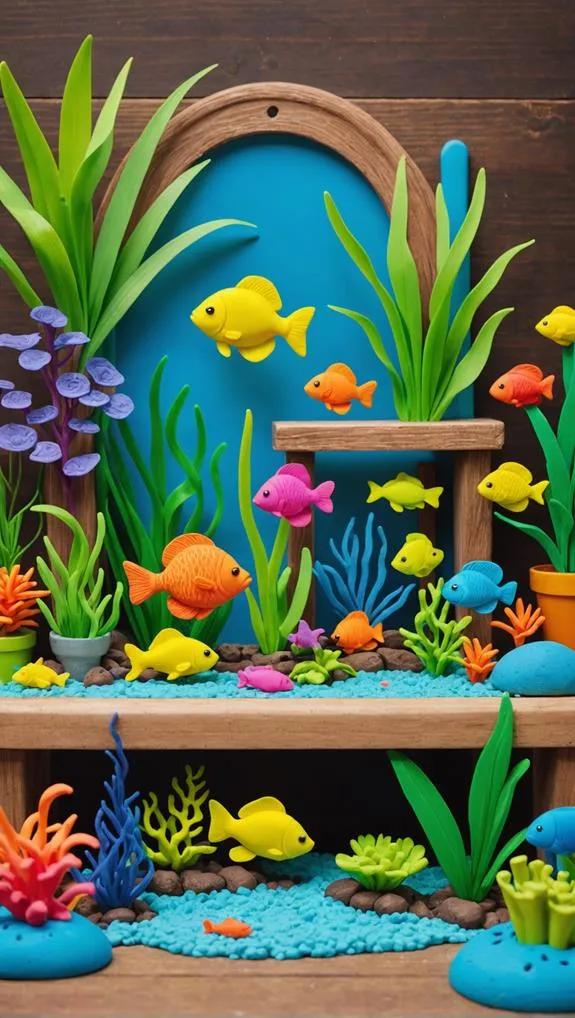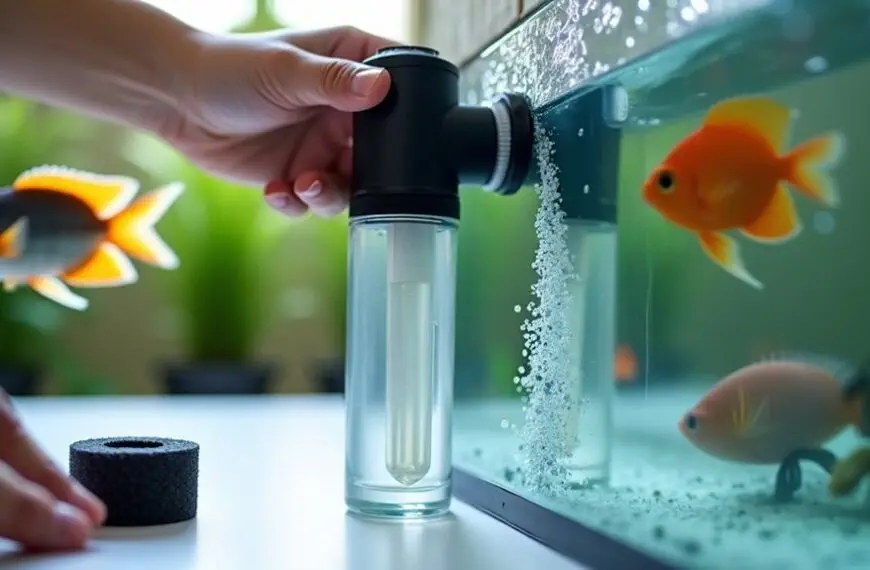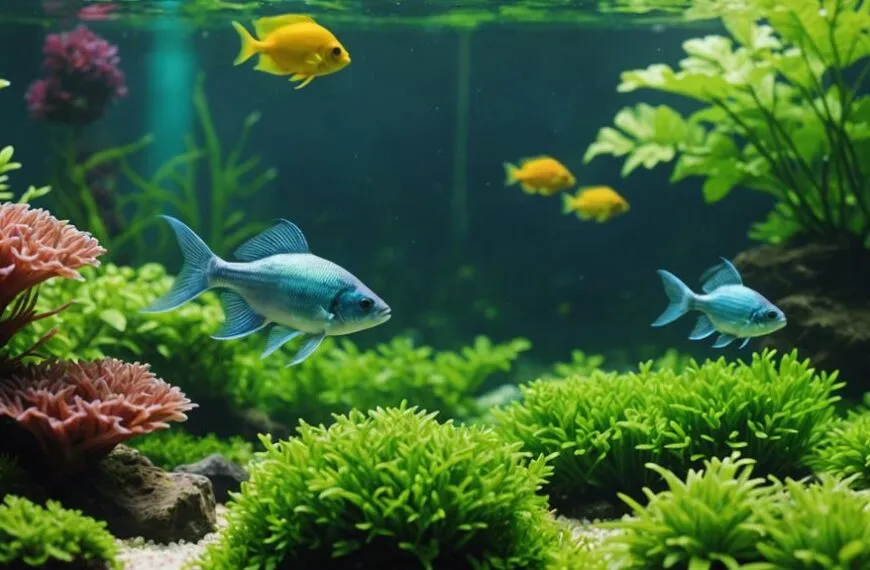Building your own DIY aquarium filter is a fun project that can save you some cash while keeping your fishy friends happy and healthy! Start by gathering a BPA-free container, 20mm PVC pipe, and some trusty adhesives. Make sure to seal everything tight with silicone to prevent leaks—nobody wants a soggy basement! Assemble your filter with a spray bar for even water flow, and connect a powerhead for circulation. Don't forget to regularly check and clean the filter parts to keep things running smoothly. Stick around, and you'll pick up even more tips to make your aquarium shine!
Contents
Materials Needed for Your Filter
To get started on your DIY aquarium filter, you'll need a few essential materials. First, grab a BPA-free airtight food container that can hold at least 2600mL. This'll be the heart of your filtration system.
Next, stock up on 20mm PVC pipe and elbow connectors. These pieces are vital for directing water flow just right.
Now, let's talk about securing everything. You'll want superglue and silicone sealant to make sure your joints are tight and leak-free. PTFE tape is your best friend for wrapping threaded connections. This little trick enhances sealing and keeps water where it belongs.
Don't forget hot glue if you need extra stability—it's like a warm hug for your filter!
Preparing the Container
Starting with a clean and sturdy container is key for your DIY aquarium filter. For this project, choose a BPA-free airtight food container with at least 2600mL capacity. This size ensures you have enough room for all the filter components while keeping the water safe.
A good filtration system is essential for a healthy fish tank environment, as it prevents waste accumulation and harmful bacteria growth regular maintenance increases tank longevity. You want to make sure that any silicone application you use is effective, so seal any openings on your chosen container. This step is crucial for preventing leaks and maintaining the efficiency of your filter.
Once you've applied the silicone, be patient—allow it to cure fully before moving on. Trust me, this is essential for achieving that perfect airtight seal. While you're waiting, test the container for airtightness by checking for leaks to confirm it can hold water without any issues.
You don't want your filter to become your aquarium's worst enemy!
Lastly, double-check that all fittings and connections are compatible with the 20mm PVC pipe. This ensures smooth assembly and functionality when you're ready to put everything together. Remember, a little extra attention now will save you from headaches later!
Assembling Your Filter

As you dive into assembling your filter, make sure your BPA-free airtight food container is completely sealed and leak-proof.
Don't skip this step; a little silicone sealant can save you from worrying about leaks down the road. Next, attach the 20mm PVC pipe to the container's outlet. Use superglue for stability, and don't forget to add a spray bar. This ensures even water distribution across your aquarium, making your fish feel right at home!
Now, customize the filter inlet to fit your tank's specific needs. This is where filter design basics come into play.
Remember to use PTFE tape on threaded connections to prevent leaks—trust me, you don't want to deal with common assembly mistakes later. Double-check all your fittings before calling it complete!
Operating the Filtration System
Operating your filtration system requires careful attention to detail to ensure optimal performance. Start by securely connecting the aquarium powerhead to the PVC pipe outlet. Make sure all fittings are airtight to prevent leaks—nobody wants a mini water feature outside the tank, right?
Maintaining proper water quality parameters is crucial, as it directly affects the health of your fish and the efficiency of your filter.
Regularly monitor the water flow rate. If it drops, check for clogs in the bio-sponge and ceramic rings; they can be sneaky little critters!
Also, inspect the powerhead for filter efficiency, as it plays a big role in keeping your water clean and clear.
Don't forget to adjust the positions of the filter inlet and outlet to achieve the best water circulation. This ensures an even distribution of clean water throughout the tank, helping your aquatic friends thrive.
Be prepared for power outages—make sure your filtration system maintains its airtight properties. This will allow for a straightforward reconnection once the power is back.
During maintenance, always test for leaks after reassembling the system, and double-check those silicone seals. You want everything to be intact before you dive back into operation! Happy filtering!
Tips for Maintaining Your Filter

Maintaining your DIY aquarium filter is essential for keeping your aquatic environment healthy and thriving.
To start, regularly check for filter leaks; ensuring all seals, especially those made with silicone sealant, are intact can save you from a soggy mess and wasted water. Additionally, it's crucial to monitor your water quality parameters, such as ammonia and nitrate levels, to ensure your filter is functioning effectively and supporting your beneficial bacteria key parameters to test.
Don't forget routine cleaning! Aim to clean the bio-sponge and ceramic rings at least once a month. This keeps them from clogging up and helps your beneficial bacteria flourish—think of them as the unsung heroes of your tank!
Also, take a moment to inspect those PVC connections and joints. Look for any signs of wear or aging, as damaged parts can really throw a wrench in your filter's performance.
If your water flow starts to dwindle, it might be time for a powerhead replacement. A good rule of thumb is to check it every six months for peak operation.
Frequently Asked Questions
How to Make a Filter for an Aquarium at Home?
To make a homemade filter for your aquarium, consider various filter material options, like bio-sponge. Regularly perform filter maintenance, and enjoy the benefits of cleaner water, healthier fish, and a thriving aquatic environment.
What Is the Best Filter for a Beginner Aquarium?
For a beginner aquarium, the best aquarium filters are often hang-on-back or sponge filters. Consider filter size to match your tank, and follow simple filter maintenance tips to keep your aquatic friends thriving.
What Can I Use as a Filter for My Fish Tank?
You can explore alternative filtration methods using DIY filter materials like sponge filters, activated carbon, or even plants for natural filtration techniques. They'll help keep your fish tank clean while serving your aquatic friends effectively.
How Do I Filter My Aquarium Water Without a Filter?
You can filter your aquarium water without a filter by using natural filtration methods. Try homemade filtration materials like live plants or activated carbon, and follow water clarity tips to maintain a healthy aquatic environment.
Final Thoughts
Now that you've built your own DIY aquarium filter, you're not just a fishkeeper; you're a fish superhero! Sure, it might feel a bit daunting at first—like juggling while riding a unicycle—but you've got this. With a bit of care and regular maintenance, your aquatic friends will thrive in their sparkling home. So, dive in, enjoy the process, and remember: even the best filters can't replace a little love and attention. Happy fishkeeping!












